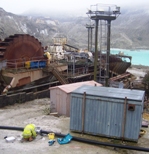The U.S. Geological Survey has purchased $3.4 million of high tech electro-acoustic instruments from SonTek/YSI.
Digital photography can replace certified smoke readers to measure opacity.

RS Hydro will install more than 250 flow monitoring stations for the cement supplier, using Siemens and Adcon technologies.
The Pennsylvania authority will pay a $320,000 civil penalty and improve its combined sewer system at an estimated cost of $10 million.
Energy Star program helps auto manufacturers and other industries cut their fossil fuel use and lower greenhouse gas emissions.
University of North Carolina, North Carolina State and the SAS Institute will use human health and biosphere data to detect bioterrorism threats before traditional disease surveillance systems do.
The Electric Power Research Institute will use a power purchase agreement for a photovoltaic solar energy system on its rooftop.
Florida Institute of Technology professor Virender Sharma has invented a product that can be used as an oxidant, disinfectant and coagulant.
A Minerals Metals & Materials Society panel completes first of two DOE-commissioned studies that are expected to help delineate an R&D portfolio for energy.
Electrolytic Technologies Corporation's Klorigen was designated a Qualified Anti-Terrorism Technology this year.

The Mustangs edged out 21 teams to win the America’s Cup of Civil Engineering.
The regulation would prioritize toxic chemicals and products, require manufacturers to seek safer alternatives to toxic chemicals in their products, and create tough governmental responses for lack of compliance.
Agency submits guidance to Congress to reinstate pollution taxes.
Vice President Joe Biden visited Midland headquarters to see the company's green tech initiatives, several of which are supported by stimulus funding.

Using a performance contract backed in part by stimulus funds, the city will install with more than 9,000 electric meters and 12,000 water meters.
A study of carbonaceous spherules found that they existed before and after the abrupt climate change that occurred 12,900 years ago.